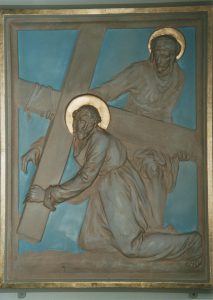The church calendar is structured around the major festivals of the Church which follow the life of Jesus as set out in the Gospels. They start at the darkest time of the year, a month before Christmas.
When there is no special liturgical season, this period is called ‘Ordinary Time’.
Each season is associated with a colour. You can find more information about these in our Did You Know? series of articles.
Click on the season or festival below to find out more about it.
Advent marks the beginning of the church year, four Sundays before Christmas Day.
This is a time of preparation and waiting and we start with a special Advent Carol Service on Advent Sunday.
At the front of the church you will see the Advent candles: three purple candles, one pink candle and one white candle. We light one each Sunday to remember:
- 1st Sunday of Advent: The Patriarchs
- 2nd Sunday of Advent: The Prophets
- 3rd Sunday of Advent: John the Baptist
- 4th Sunday of Advent: The Virgin Mary
- Christmas Day: Jesus Christ
We celebrate the birth of Jesus at the most well-known Christian festival.
As we approach Christmas, we hold a number of special services:
- The Christingle, where children are given oranges decorated with candles, and process (under adult supervision) round the church, to bring the light of Christ to the world
- The very popular Carols by Candlelight service with special Christmas music and a chance to sing your favourite carols
- The Crib Service on Christmas Eve when the children re-enact the Nativity story
The Christmas tree is set up in church and decorated with the names of those we wish to remember.
The major services for Christmas are:
- Midnight Mass which is a modern language service
- Holy Communion and the Parish Eucharist on Christmas Day
The Christmas season continues until the Feast and Season of Epiphany, twelve days later, when we celebrate the showing of Christ to the world, and the figures of the Wise Men from the East are added to our crib scene.
Epiphany ends with the celebration of the Presentation of Christ in the Temple, usually called Candlemas, marked by the renewal of our Baptismal vows.
There follows a period of Ordinary Time which varies in length according to the date of Easter.
This is the season of preparation for Easter, traditionally commemorating Christ’s forty days of fasting in the wilderness.
Lent begins with Ash Wednesday; at a special service those who wish are marked with a cross on their foreheads as a sign of penitence.
Although the tradition is to ‘give something up’ for Lent, the Church’s emphasis nowadays is on positive action. There may be special talks or discussion groups.
The fourth Sunday of Lent is Mothering Sunday; we have a special Family Service, and bunches of flowers are given to all the ladies present.
The two weeks leading up to Easter are known as Passiontide; we think of the events leading the Christ’s suffering and death on the cross. The church ornaments and figures of Christ are covered or removed.
One week later comes Palm Sunday; at the Parish Eucharist there is a procession commemorating Jesus’ entry into Jerusalem and crosses made of palm leaves are blessed to be taken home and kept for the coming year.
The week following Palm Sunday is known as Holy Week; there are special services throughout the week.
On Maundy Thursday we have Eucharist service in the evening, after which the church altars are stripped. We then hold a vigil, the ‘Watch of the Passion’.
The church is bare. At midday we have a devotional service, followed by a meditation on the Passion of Christ on the cross.
The church is made ready to celebrate the resurrection of Christ.
In the evening, we have the ‘Service of Light’; a fire is kindled in the churchyard, from which the new Easter Candle is lit and carried into the church.
There is a short service of Bible readings, after which those present are again marked with a cross on the forehead, this time from the water of baptism.
The crown of the Church’s year is the rejoicing of Easter Day when we give thanks for the new life of the risen Christ.
The day starts with the ‘Easter Alleluia’, an informal service in which all the churches of Rickmansworth join. Holy Communion and the Parish Eucharist are celebrated in church.
The Season of Easter continues until Ascension Day – the commemoration of the departure of Jesus in visible, bodily form from this world and his return to the world of the divine. This was a prelude to the gift from God of the Holy Spirit at Pentecost (otherwise Whit Sunday). This concludes the season of Easter.
Trinity Sunday follows to mark the totality of God, Father, Son and Holy Spirit.
From now until Advent Sunday is a long period of Ordinary Time; the Gospel Story has been told through the Church Festivals, but there are more special occasions to come.
This is a bit like our birthday and is celebrated on the nearest Sunday to 8 September, one of the feast days of St Mary the Virgin.
We usually hold a special service and enjoy hospitality together.
This service is usually held on the first Sunday in October with a collection of non-perishable items in aid of a local charity, usually one working with the homeless.
The collection is sent to the Bishop of St Albans Harvest for the Hungry Appeal.
At the beginning of November we commemorate the departed at which the names of those we have loved and lost are read out.
As with all our services at St Mary’s, everyone is welcome to attend and ask for the name(s) of those they wish to be remembered to be included on the roll call.
This is a very special occasion as the town war memorial is in our churchyard.
There is a procession from Our Lady Help of Christians Church at the far end of the High Street, followed by a service at the war memorial in the churchyard. At this service, local organisations lay wreaths of poppies on the memorial.
The round of the year is now complete, and it is time to look again towards Advent.



